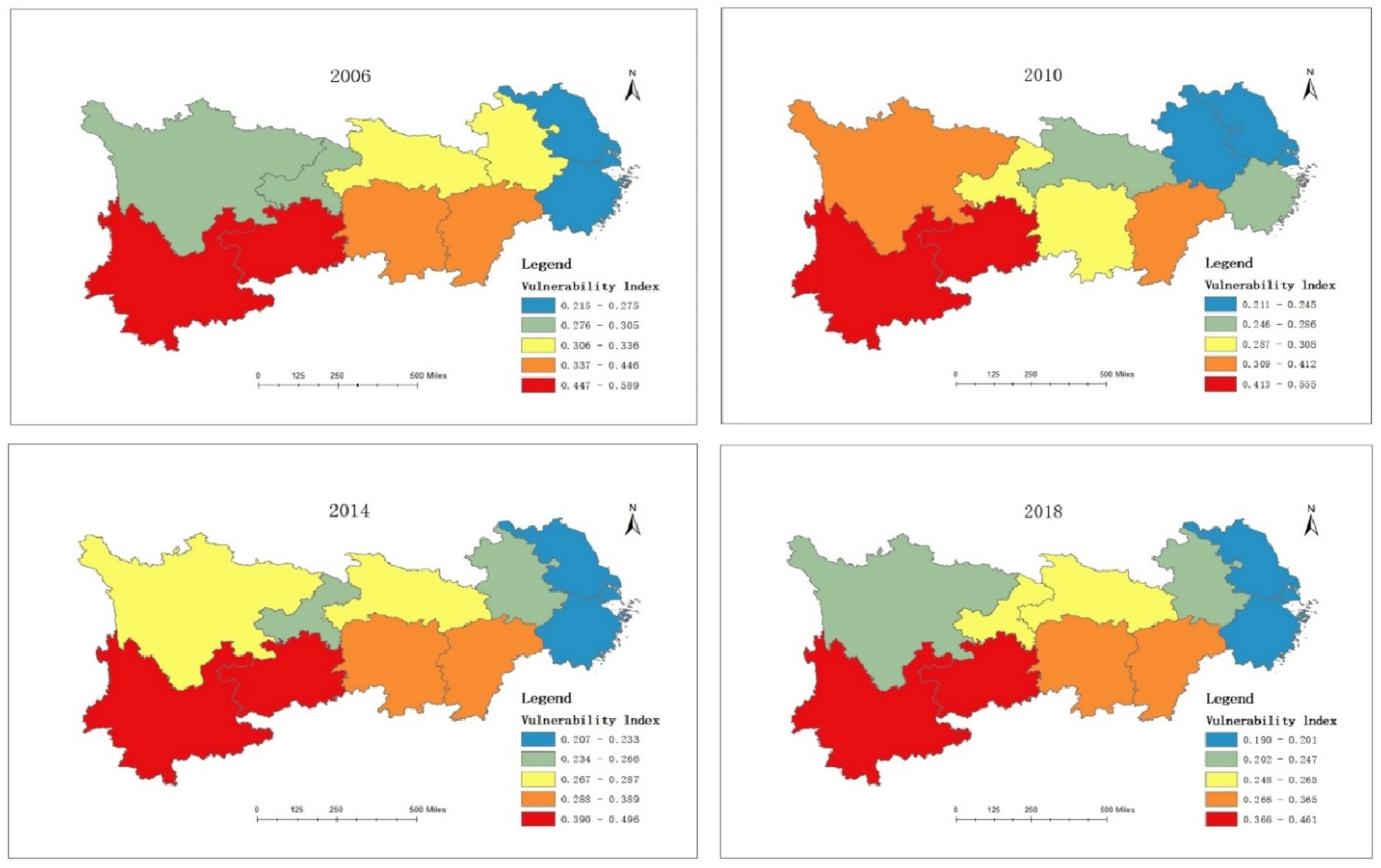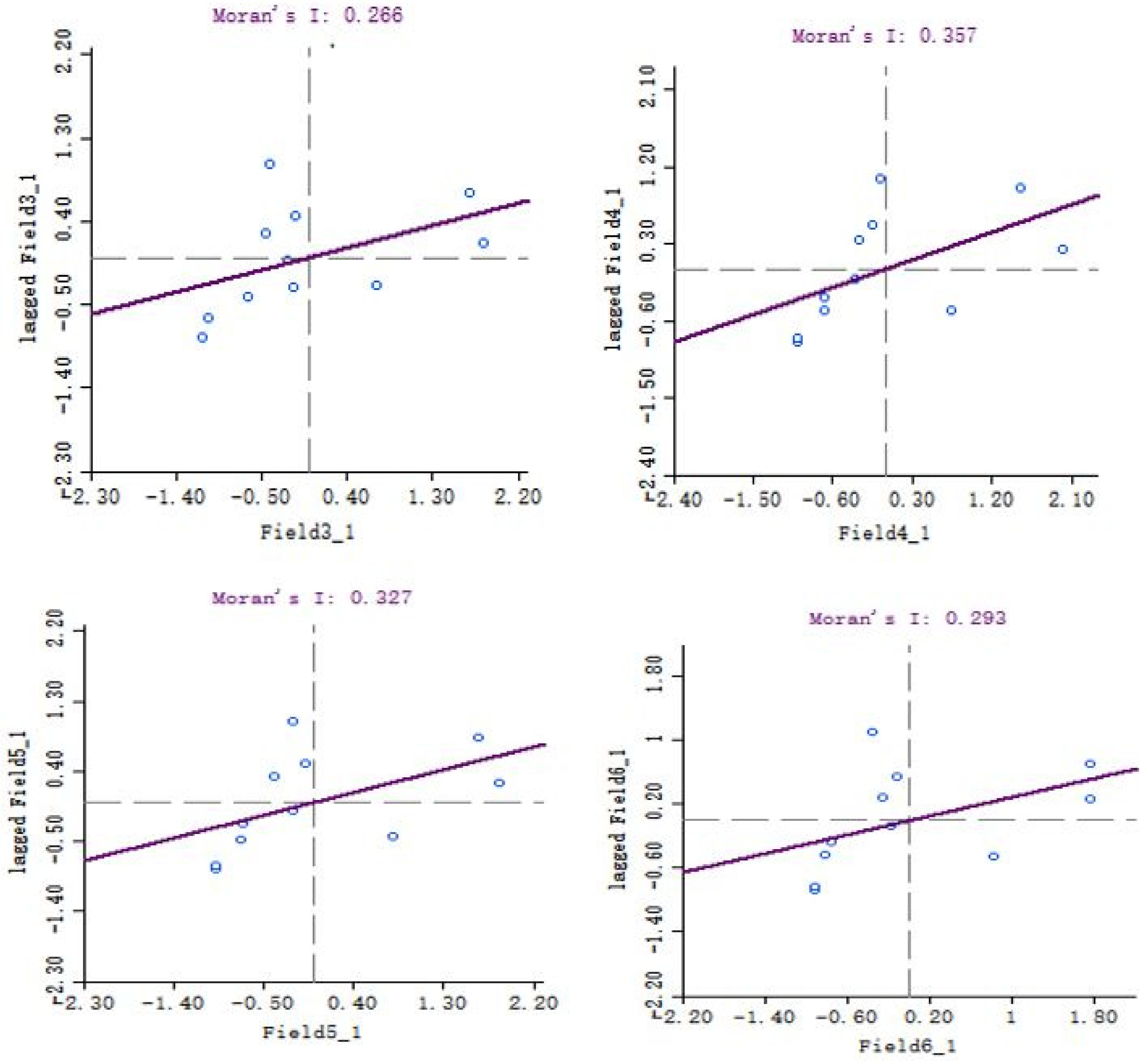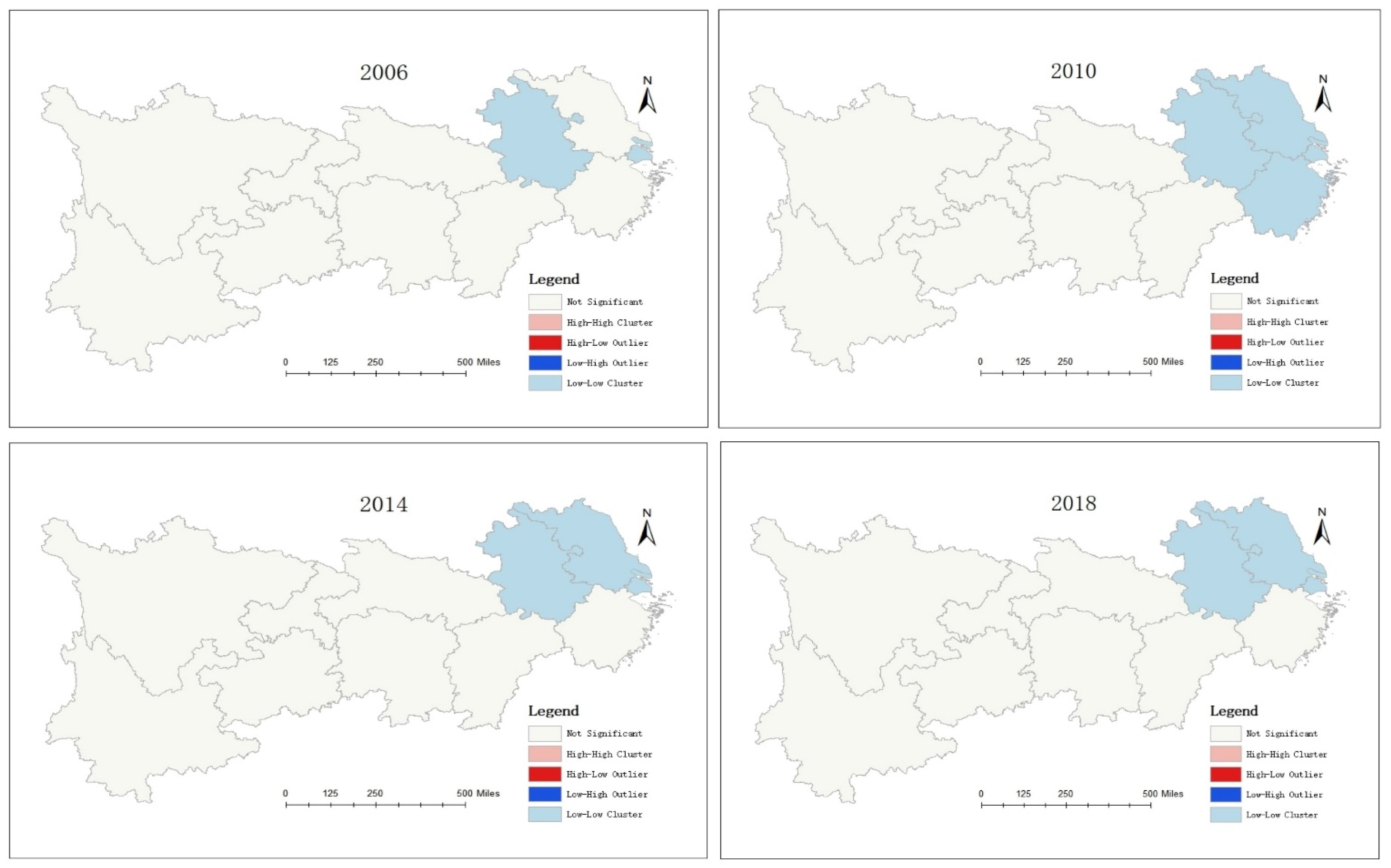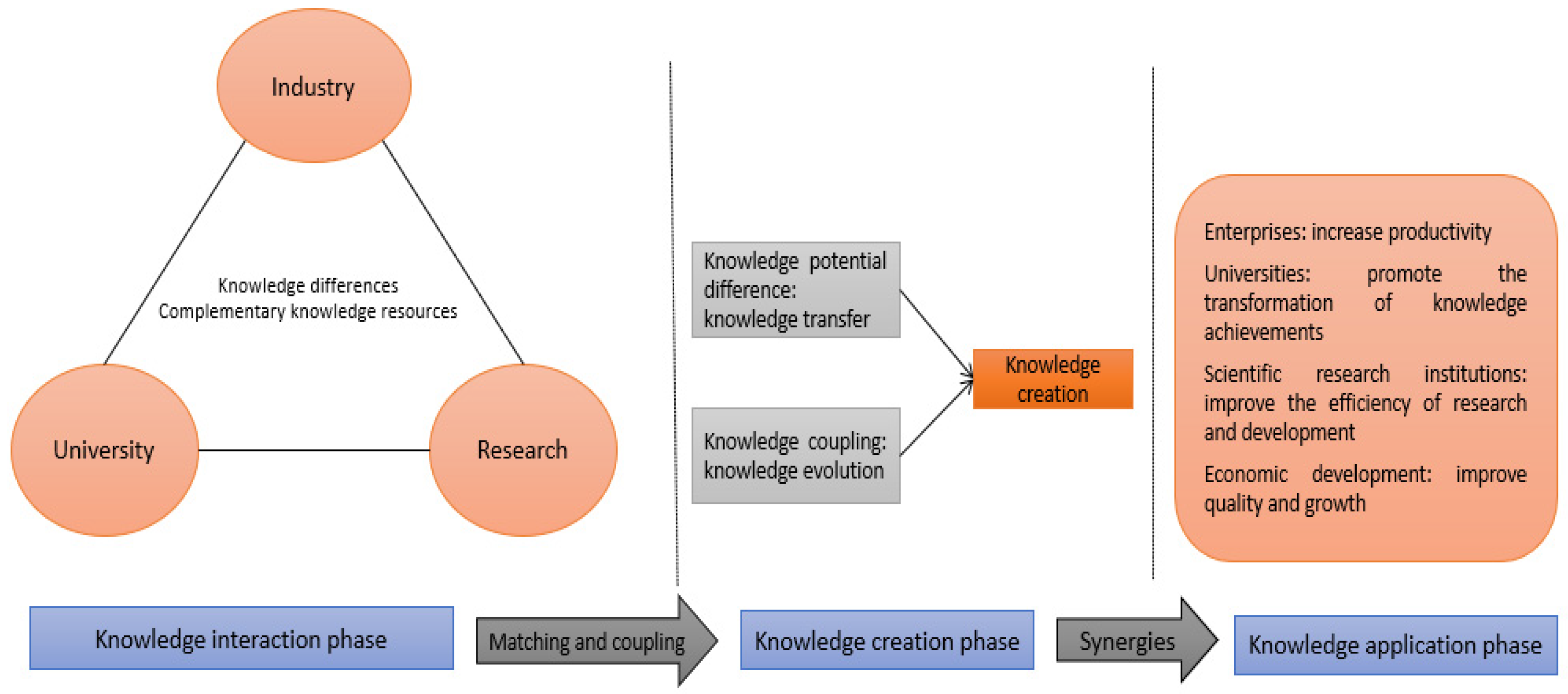Spatio-Temporal Evolution and Development Path of Industry–University–Research Cooperation and Economic Vulnerability: Evidence from China’s Yangtze River Economic Belt
Abstract
:1. Introduction
- (a)
- How does industry–university–research (IUR) cooperation impact Chinese economy?
- (b)
- What level of economic vulnerability prevails in the IUR-driven Chinese economy?
2. Materials and Methods
2.1. Study Area Overview
2.2. Indicator Selection and Data Sources
2.3. Research Methods
2.3.1. Entropy Weight Method
2.3.2. Vulnerability Calculation
2.3.3. Spatial Autocorrelation Model
3. Results and Discussion
3.1. Vulnerability Index Timing Evolution Analysis
3.2. Spatial Analysis of Vulnerability
3.2.1. Spatial Distribution Characteristics
3.2.2. Spatial Correlation Analysis
3.3. Development Path Analysis
3.3.1. Knowledge Interaction Phase
3.3.2. Knowledge Creation Phase
3.3.3. Knowledge Application Phase
4. Conclusions and Recommendations
- (1)
- From the perspective of time-series changes, the vulnerability index showed a good development trend in the period from 2006–2018, as well as the volatility of the sensitivity index and a decrease in the vulnerability index. The response ability index gradually increased, especially in the later period, showing a good trend of low sensitivity, high response ability, and low vulnerability.
- (2)
- From the perspective of spatial evolution, the overall vulnerability index showed a downward trend, but the development process was unstable, with an overall evolution pattern of “ladderization” in the eastern part < the central part < the western part. The characteristics of “extreme difference” and evolution path of “agglomeration” were presented. In addition, an obvious spatial positive correlation was found between IUR cooperation in the YREB region, as well as the vulnerability of the economic development system, which is spatially dependent.
- (3)
- From the perspective of the development path, the impact mechanism of IUR cooperation on regional economic development can be divided into three phases: knowledge interaction phase, knowledge creation phase, and knowledge application phase.
Author Contributions
Funding
Institutional Review Board Statement
Informed Consent Statement
Data Availability Statement
Conflicts of Interest
References
- Eom, B.Y.; Lee, K. Determinants of Industry-Academy Linkages and, Their Impact on Firm Performance: The Case of Korea as a Latecomer in Knowledge Industrialization. Res. Policy 2010, 39, 625–639. [Google Scholar] [CrossRef]
- Xu, X.; Zhu, Y.; Xu, L.; Wang, Z. Influence of Industry-University Cooperation on Economic Development: A Mathematical Statistical Analysis. Math. Probl. Eng. 2021, 2021, 6645978. [Google Scholar] [CrossRef]
- Cui, Z.; Li, E. Does Industry-University-Research Cooperation Matter? An Analysis of Its Coupling Effect on Regional Innovation and Economic Development. Chin. Geogr. Sci. 2022, 32, 915–930. [Google Scholar] [CrossRef]
- Motoyama, Y. Long-Term Collaboration between University and Industry: Acase Study of Nanotechnology Development in Japan. Technol. Soc. 2014, 36, 39–51. [Google Scholar] [CrossRef]
- Rybnicek, R.; Königsgruber, R. What Makes Industry–University Collaboration Succeed? A Systematic Review of the Literature. J. Bus. Econ. 2019, 89, 221–250. [Google Scholar] [CrossRef] [Green Version]
- Moore, A.W.; King, L.; Dale, A.; Newell, R. Toward an Integrative Framework for Local Development Path Analysis. Ecol. Soc. 2018, 23, art13. [Google Scholar] [CrossRef] [Green Version]
- Bai, X.-J.; Li, Z.-Y.; Zeng, J. Performance Evaluation of China’s Innovation during the Industry-University-Research Collaboration Process—An Analysis Basis on the Dynamic Network Slacks-Based Measurement Model. Technol. Soc. 2020, 62, 101310. [Google Scholar] [CrossRef]
- Etzkowitz, H. The Triple Helix: University–Industry–Government Innovation in Action; Etzkowitz, H., Ed.; Routledge: New York, NY, USA; Routledge: London, UK, 2008; ISBN 978-0-415-96451-7. [Google Scholar]
- Farinha, L.; Ferreira, J.; Gouveia, B. Networks of Innovation and Competitiveness: A Triple Helix Case Study. J. Knowl. Econ. 2016, 7, 259–275. [Google Scholar] [CrossRef]
- Lan, J. A Dynamic Analysis of Triple Helix of Industry-University-Research Institution: The Case of China. In Proceedings of the 2008 4th International Conference on Wireless Communications, Networking and Mobile Computing, Dalian, China, 12–17 October 2008; pp. 1–6. [Google Scholar]
- Li, E.; Yao, F.; Xi, J.; Guo, C. Evolution Characteristics of Government-Industry-University-Research Cooperative Innovation Network for China’s Agriculture and Influencing Factors: Illustrated According to Agricultural Patent Case. Chin. Geogr. Sci. 2018, 28, 137–152. [Google Scholar] [CrossRef] [Green Version]
- Tu, Z.Z.; Gu, X.; Ye, Y.J. Synergy Evaluation of Industry-University-Research Institute Synergetic Innovation System Based on Knowledge Creation. J. Discret. Math. Sci. Cryptogr. 2017, 20, 361–376. [Google Scholar] [CrossRef]
- Tsaramirsis, G.; Kantaros, A.; Al-Darraji, I.; Piromalis, D.; Apostolopoulos, C.; Pavlopoulou, A.; Alrammal, M.; Ismail, Z.; Buhari, S.M.; Stojmenovic, M.; et al. A Modern Approach towards an Industry 4.0 Model: From Driving Technologies to Management. J. Sens. 2022, 2022, 5023011. [Google Scholar] [CrossRef]
- Grimpe, C.; Hussinger, K. Formal and Informal Knowledge and Technology Transfer from Academia to Industry: Complementarity Effects and Innovation Performance. Ind. Innov. 2013, 20, 683–700. [Google Scholar] [CrossRef] [Green Version]
- Huang, C.; Lin, F.; Chu, D.; Wang, L.; Liao, J.; Wu, J. Spatiotemporal Evolution and Trend Prediction of Tourism Economic Vulnerability in China’s Major Tourist Cities. ISPRS Int. J. Geo-Inf. 2021, 10, 644. [Google Scholar] [CrossRef]
- Wu, Y.; Li, X.; Zhang, Z. An Empirical Study on the Influencing Factors of Knowledge Governance of Industry-University-Research Synergetic Innovation; Springer International Publishing: Berlin/Heidelberg, Germany, 2021; Volume 79, ISBN 9783030792060. [Google Scholar]
- Li, B.; Luo, X.; Su, Y. Evolution Mechanism of the Original Innovation System of an Enterprise’s Industry-University-Research Cooperation. Harbin Gongcheng Daxue Xuebao/J. Harbin Eng. Univ. 2014, 35, 654–660. [Google Scholar] [CrossRef]
- Atteridge, A.; Remling, E. Is Adaptation Reducing Vulnerability or Redistributing It? WIREs Clim. Change 2018, 9, e500. [Google Scholar] [CrossRef]
- Huang, C.Y. How Background, Motivation, and the Cooperation Tie of Faculty Members Affect Their University–Industry Collaboration Outputs: An Empirical Study Based on Taiwan Higher Education Environment. Asia Pac. Educ. Rev. 2018, 19, 413–431. [Google Scholar] [CrossRef]
- Fu, L.; Zhou, X.; Luo, Y. The Research on Knowledge Spillover of Industry-University-Research Institute Collaboration Innovation Network. In Proceedings of the 19th International Conference on Industrial Engineering and Engineering Management, Changsha, China, 27–29 October 2012; Springer: Berlin, Heidelberg, 2013; pp. 361–371, ISBN 9783642384264. [Google Scholar]
- Kates, R.W.; Clark, W.C.; Corell, R.; Hall, J.M.; Jaeger, C.C.; Lowe, I.; McCarthy, J.J.; Schellnhuber, H.J.; Bolin, B.; Dickson, N.M.; et al. Environment and Development: Sustainability Science. Science 2001, 292, 641–642. [Google Scholar] [CrossRef] [PubMed]
- Turner, B.L.; Kasperson, R.E.; Matsone, P.A.; McCarthy, J.J.; Corell, R.W.; Christensene, L.; Eckley, N.; Kasperson, J.X.; Luers, A.; Martello, M.L.; et al. A Framework for Vulnerability Analysis in Sustainability Science. Proc. Natl. Acad. Sci. USA 2003, 100, 8074–8079. [Google Scholar] [CrossRef] [PubMed] [Green Version]
- Janssen, M.A.; Schoon, M.L.; Ke, W.; Börner, K. Scholarly Networks on Resilience, Vulnerability and Adaptation within the Human Dimensions of Global Environmental Change. Glob. Environ. Change 2006, 16, 240–252. [Google Scholar] [CrossRef] [Green Version]
- Etzold, B.; Sakdapolrak, P. Socio-Spatialities of Vulnerability towards a Polymorphic Perspective in Vulnerability Research. J. Geogr. Soc. Berlin 2016, 4, 234–251. [Google Scholar] [CrossRef]
- Bao, L. The Research on Social Capital of Industry-University-Research Institute Cooperation. Asian Soc. Sci. 2009, 4, 118–176. [Google Scholar] [CrossRef] [Green Version]
- Frazier, T.G.; Thompson, C.M.; Dezzani, R.J. A Framework for the Development of the SERV Model: A Spatially Explicit Resilience-Vulnerability Model. Appl. Geogr. 2014, 51, 158–172. [Google Scholar] [CrossRef]
- Rocha, K.; Moreira, A. The Role of Domestic Fundamentals on the Economic Vulnerability of Emerging Markets. Emerg. Mark. Rev. 2010, 11, 173–182. [Google Scholar] [CrossRef]
- Wang, C.C. Reconsidering the Economic Vulnerability Index of the United Nations. Can. J. Dev. Stud. 2013, 34, 553–568. [Google Scholar] [CrossRef]
- Gnangnon, S.K. Effect of Multilateral Trade Liberalization on Foreign Direct Investment Outflows amid Structural Economic Vulnerability in Developing Countries. Res. Int. Bus. Financ. 2018, 45, 15–29. [Google Scholar] [CrossRef]
- Guillaumont, P. The Concept of Structural Economic Vulnerability and Its Relevance for the Identification of the Least Developed Countries and Other Purposes (Nature, Measurement, and Evolution). CDP Backgr. Pap. 2011, 12, 1–7. [Google Scholar]
- Cheng, J.; Tao, J.P. Fuzzy Comprehensive Evaluation of Drought Vulnerability Based on the Analytic Hierarchy Process—An Empirical Study from Xiaogan City in Hubei Province. Agric. Agric. Sci. Procedia 2010, 1, 126–135. [Google Scholar] [CrossRef] [Green Version]
- Chen, J.; Yang, X.; Yin, S.; Wu, K. The Vulnerability Evolution and Simulation of the Social-Ecological Systems in the Semi-Arid Area Based on the VSD Framework. Dili Xuebao/Acta Geogr. Sin. 2016, 71, 1172–1188. [Google Scholar] [CrossRef]
- Wu, J.; Han, G.; Zhou, H.; Li, N. Economic Development and Declining Vulnerability to Climate-Related Disasters in China. Environ. Res. Lett. 2018, 13, 034013. [Google Scholar] [CrossRef]
- Sarker, M.N.I.; Cao, Q.; Wu, M.; Hossin, M.A.; Alam, G.M.; Shouse, R.C. Vulnerability and Livelihood Resilience in the Face of Natural Disaster: A Critical Conceptual Review. Appl. Ecol. Environ. Res. 2019, 17, 12769–12785. [Google Scholar] [CrossRef]
- Huq, M.E.; Shao, Z.; Al Dughairi, A.A.; Sarker, M.N.I.; Bowen, C.; Al Mamun, A.; Saleem, N.; Javed, A.; Rahman, M.M. Measuring Vulnerability to Flash Flood of Urban Dwellers. In Wadi Flash Floods; Springer: Singapore, 2022; pp. 317–354. ISBN 9789811629044. [Google Scholar]
- Fan, Y.; Fang, C.; Zhang, Q. Coupling Coordinated Development between Social Economy and Ecological Environment in Chinese Provincial Capital Cities—Assessment and Policy Implications. J. Clean. Prod. 2019, 229, 289–298. [Google Scholar] [CrossRef]
- Wan, J.; Zhang, L.; Yan, J.; Wang, X.; Wang, T. Spatial–Temporal Characteristics and Influencing Factors of Coupled Coordination between Urbanization and Eco-Environment: A Case Study of 13 Urban Agglomerations in China. Sustainability 2020, 12, 8821. [Google Scholar] [CrossRef]
- Ariken, M.; Zhang, F.; Weng Chan, N.; Kung, H. Coupling Coordination Analysis and Spatio-Temporal Heterogeneity between Urbanization and Eco-Environment along the Silk Road Economic Belt in China. Ecol. Indic. 2021, 121, 107014. [Google Scholar] [CrossRef]
- Li, W.; Xia, H.; Guo, W. Distributed Data Collaborative Fusion Method for Industry-University-Research Cooperation Innovation System Based on Machine Learning; Springer International Publishing: Berlin/Heidelberg, Germany, 2021; Volume 347, ISBN 9783030678708. [Google Scholar]
- Wang, S.; Wang, J.; Wei, C.; Wang, X.; Fan, F. Collaborative Innovation Efficiency: From within Cities to between Cities—Empirical Analysis Based on Innovative Cities in China. Growth Change 2021, 52, 1330–1360. [Google Scholar] [CrossRef]
- Li, Z.; Wan, T.; Lan, J. Substitution or Complementarity: Influence of Industry–University–Research-Institute Cooperation Governance Mechanism on Knowledge Transfer—An Empirical Analysis from China. Sustainability 2022, 14, 7606. [Google Scholar] [CrossRef]
- Changle, X.; Tingting, X. Status Quo, Problems and Development Countermeasures of Industrial Division of Labor and Cooperation in the Yangtze River Economic Belt. Resour. Environ. Yangtze River Basin 2015, 24, 1634–1638. [Google Scholar]
- Li, M.; Zhang, M.; Agyeman, F.O.; ud din Khan, H.S. Research on the Influence of Industry-University-Research Cooperation Innovation Network Characteristics on Subject Innovation Performance. Math. Probl. Eng. 2021, 2021, 4771113. [Google Scholar] [CrossRef]
- Zhao, Y.; Wang, S.; Zhou, C. Understanding the Relation between Urbanization and the Eco-Environment in China’s Yangtze River Delta Using an Improved EKC Model and Coupling Analysis. Sci. Total Environ. 2016, 571, 862–875. [Google Scholar] [CrossRef]
- Lifeng, H. Solidly Promote the High-Quality Developmen Map River Economic Belt. 2019, pp. 1–5. Available online: http://www.qstheory.cn/dukan/qs/2019-09/16/c_1124994831.htm (accessed on 10 December 2021).
- Liu, J.; Tian, Y.; Huang, K.; Yi, T. Spatial-Temporal D ifferentiation of the Coupling Coordinated Development of Regional Energy-Economy-Ecology System: A Case Study of the Yangtze River Economic Belt. Ecol. Indic. 2021, 124, 107394. [Google Scholar] [CrossRef]
- Buesa, M.; Heijs, J.; Baumert, T. The Determinants of Regional Innovation in Europe: A Combined Factorial and Regression Knowledge Production Function Approach. Res. Policy 2010, 39, 722–735. [Google Scholar] [CrossRef]
- Graf, H.; Henning, T. Public Research in Regional Networks of Innovators: A Comparative Study of Four East German Regions. Reg. Stud. 2009, 43, 1349–1368. [Google Scholar] [CrossRef]
- Cowan, R.; Zinovyeva, N. University Effects on Regional Innovation. Res. Policy 2013, 42, 788–800. [Google Scholar] [CrossRef]
- Fritsch, M.; Slavtchev, V. How Does Industry Specialization Affect the Efficiency of Regional Innovation Systems? Ann. Reg. Sci. 2010, 45, 87–108. [Google Scholar] [CrossRef] [Green Version]
- Speranza, C.I.; Wiesmann, U.; Rist, S. An Indicator Framework for Assessing Livelihood Resilience in the Context of Social–Ecological Dynamics. Glob. Environ. Change 2014, 28, 109–119. [Google Scholar] [CrossRef]
- Polsky, C.; Neff, R.; Yarnal, B. Building Comparable Global Change Vulnerability Assessments: The Vulnerability Scoping Diagram. Glob. Environ. Change 2007, 17, 472–485. [Google Scholar] [CrossRef]
- Acosta-Michlik, L.; Espaldon, V. Assessing Vulnerability of Selected Farming Communities in the Philippines Based on a Behavioural Model of Agent’s Adaptation to Global Environmental Change. Glob. Environ. Change 2008, 18, 554–563. [Google Scholar] [CrossRef]
- Sarker, M.N.I.; Wu, M.; Alam, G.M.; Shouse, R.C. Livelihood Vulnerability of Riverine-Island Dwellers in the Face of Natural Disasters in Bangladesh. Sustainability 2019, 11, 1623. [Google Scholar] [CrossRef] [Green Version]
- Chen, P.; Chen, X. Summary on Research of Coupled Human-Environment System Vulnerability under Global Environmental Change. Prog. Geogr. 2010, 29, 454–462. [Google Scholar] [CrossRef]
- Sarker, M.N.I.; Wu, M.; Shouse, R.C.; Ma, C. Administrative Resilience and Adaptive Capacity of Administrative System: A Critical Conceptual Review. In Lecture Notes on Multidisciplinary Industrial Engineering; Xu, J., Ahmed, S., Cooke, F., Duca, G., Eds.; Springer Nature: Cham, Switzerland, 2019; pp. 1–13. [Google Scholar]
- Lixin, Z.; Xinjun, Y.; Jia, C.; Ziqiao, W.; Jing, Z.; Jie, Y. Vulnerability Evaluation and Impact Mechanism of Human-Land System in the Great Ruins Area: A Case Study of the Great Ruins Area of Han Chang’an City. Resour. Sci. 2015, 37, 1848–1859. [Google Scholar]
- Zhang, H.; Chen, W.; Liu, Z. Spatiotemporal Evolution of Entrepreneurial Activities and Its Driving Factors in the Yangtze River Delta, China. Land 2022, 11, 216. [Google Scholar] [CrossRef]
- Li, Z.; Wu, J.; Cui, X.; Mi, Z.; Peng, L. Assessment and Influencing Factors Analysis of Economic System Vulnerability of the Belt and Road Initiative Countries. PLoS ONE 2022, 17, e0262611. [Google Scholar] [CrossRef] [PubMed]
- Morandi, V. The Management of Industry–University Joint Research Projects: How Do Partners Coordinate and Control R&D Activities? J. Technol. Transf. 2013, 38, 69–92. [Google Scholar] [CrossRef]
- Shin, S.J.; Kim, T.Y.; Lee, J.Y.; Bian, L. Cognitive Team Diversity and Individual Team Member Creativity: A Cross-Level Interaction. Acad. Manag. J. 2012, 55, 197–212. [Google Scholar] [CrossRef]
- Tang, D.; Mao, M.; Shi, J.; Hua, W. The Spatio-Temporal Analysis of Urban-Rural Coordinated Development and Its Driving Forces in Yangtze River Delta. Land 2021, 10, 495. [Google Scholar] [CrossRef]
- Nicli, S.; Elsen, S.U.; Bernhard, A. Eco-Social Agriculture for Social Transformation and Environmental Sustainability: A Case Study of the UPAS-Project. Sustainability 2020, 12, 5510. [Google Scholar] [CrossRef]
- Zhang, S.; Wang, X. Does Innovative City Construction Improve the Industry–University–Research Knowledge Flow in Urban China? Technol. Forecast. Soc. Change 2022, 174, 121200. [Google Scholar] [CrossRef]
- Anklam, P. Knowledge Management: The Collaboration Thread. Bull. Am. Soc. Inf. Sci. Technol. 2002, 28, 8. [Google Scholar] [CrossRef]
- Salazar, A.E.R.; Domínguez-Crespo, M.A.; Torres-Huerta, A.M.; Licona-Aguilar, A.I.; Nivón-Pellón, A.; Orta-Guzmán, V.N. Analysis of the Dynamical Capabilities into the Public Research Institutes to Their Strategic Decision-Making. Sustainabi.ity 2021, 13, 6672. [Google Scholar] [CrossRef]
- Dai, P.; Lin, Y. Should There Be Industrial Agglomeration in Sustainable Cities?: A Perspective Based on Haze Pollution. Sustainability 2021, 13, 6609. [Google Scholar] [CrossRef]





| System Layer | Dimension Layer | Index Layer | Nature |
|---|---|---|---|
| Industry–university–research (IUR) cooperation and c | Industry | Government funds in R&D expenditure (10 thousand yuan) | Sensitivity (S) |
| Internal expenditure of R&D expenditure (10 thousand yuan) | Coping ability (R) | ||
| New product development funds accounted for as a proportion of main business income (%) | Sensitivity (S) | ||
| Proportion of new product sales revenue to main business revenue (%) | Sensitivity (S) | ||
| Number of R&D projects (a) | Coping ability (R) | ||
| R&D project personnel accounted for as a proportion of all employees (%) | Sensitivity (S) | ||
| R&D project funding investment (10 thousand yuan) | Coping ability (R) | ||
| Number of enterprise R&D institutions (a) | Coping ability (R) | ||
| Number of invention patents (pieces) | Coping ability (R) | ||
| High-paying technology industry accounted for as a proportion of main business income (%) | Sensitivity (S) | ||
| University | Government funds in R&D expenditure (10 thousand yuan) | Sensitivity (S) | |
| Internal expenditure of R&D expenditure (10 thousand yuan) | Coping ability (R) | ||
| R&D project personnel accounted for as a proportion of all employees (%) | Sensitivity (S) | ||
| Number of R&D projects (a) | Coping ability (R) | ||
| R&D project personnel input (persons) | Coping ability (R) | ||
| R&D project funding investment (10 thousand yuan) | Coping ability (R) | ||
| Number of R&D institutions owned (a) | Coping ability (R) | ||
| Number of invention patents (pieces) | Coping ability (R) | ||
| Number of scientific papers published (papers) | Coping ability (R) | ||
| Research institution | Government funds in R&D expenditure (10 thousand yuan) | Sensitivity (S) | |
| Internal expenditure of R&D expenditure (10 thousand yuan) | Coping ability (R) | ||
| R&D project personnel accounted for as a proportion of all employees (%) | Sensitivity (S) | ||
| Number of R&D projects (a) | Coping ability (R) | ||
| R&D project personnel input (persons) | Coping ability (R) | ||
| R&D project funding investment (10 thousand yuan) | Coping ability (R) | ||
| Number of R&D institutions owned (a) | Coping ability (R) | ||
| Number of invention patents (pieces) | Coping ability (R) | ||
| Number of scientific papers published (papers) | Coping ability (R) | ||
| Industry–university–research (IUR) interaction | Technology market turnover (100 million yuan) | Sensitivity (S) | |
| Amount of funds from enterprises in funds for scientific and technological activities of universities and scientific research institutions (10 thousand yuan) | Sensitivity (S) | ||
| Number of patents applied for by the three parties of industry, university, and research, or by two of them, jointly accounted for as a proportion of the total number of patents (%) | Sensitivity (S) | ||
| Number of papers published by industry–university–research (IUR) cooperation (papers) | Sensitivity (S) | ||
| Economic development | Gross domestic product (GDP) per capita (yuan) | Coping ability (R) | |
| Local public budget revenue (100 million yuan) | Coping ability (R) | ||
| Per capita disposable income of urban residents (yuan) | Coping ability (R) | ||
| Per capita disposable income of rural residents (yuan) | Coping ability (R) | ||
| Proportion of tertiary industry in GDP (%) | Sensitivity (S) | ||
| R&D expenditure as a proportion of GDP (%) | Sensitivity (S) | ||
| Overall labor productivity (%) | Coping ability (R) | ||
| Regional innovation ability index (constant) | Coping ability (R) | ||
| Degree of deviation of industrial structure (constant) | Sensitivity (S) | ||
| Industrial structure advanced index (constant) | Sensitivity (S) |
| Year | Moran’s I Index | z-Value | p-Value |
|---|---|---|---|
| 2006 | 0.266 | 1.947 | 0.030 |
| 2010 | 0.357 | 2.433 | 0.020 |
| 2014 | 0.327 | 2.192 | 0.025 |
| 2018 | 0.293 | 1.949 | 0.045 |
Publisher’s Note: MDPI stays neutral with regard to jurisdictional claims in published maps and institutional affiliations. |
© 2022 by the authors. Licensee MDPI, Basel, Switzerland. This article is an open access article distributed under the terms and conditions of the Creative Commons Attribution (CC BY) license (https://creativecommons.org/licenses/by/4.0/).
Share and Cite
Zhang, F.; Lv, Y.; Sarker, M.N.I. Spatio-Temporal Evolution and Development Path of Industry–University–Research Cooperation and Economic Vulnerability: Evidence from China’s Yangtze River Economic Belt. Sustainability 2022, 14, 12919. https://doi.org/10.3390/su141912919
Zhang F, Lv Y, Sarker MNI. Spatio-Temporal Evolution and Development Path of Industry–University–Research Cooperation and Economic Vulnerability: Evidence from China’s Yangtze River Economic Belt. Sustainability. 2022; 14(19):12919. https://doi.org/10.3390/su141912919
Chicago/Turabian StyleZhang, Fengting, Yang Lv, and Md Nazirul Islam Sarker. 2022. "Spatio-Temporal Evolution and Development Path of Industry–University–Research Cooperation and Economic Vulnerability: Evidence from China’s Yangtze River Economic Belt" Sustainability 14, no. 19: 12919. https://doi.org/10.3390/su141912919







